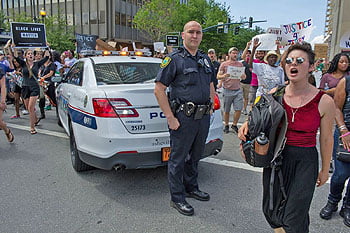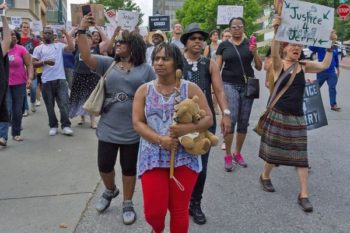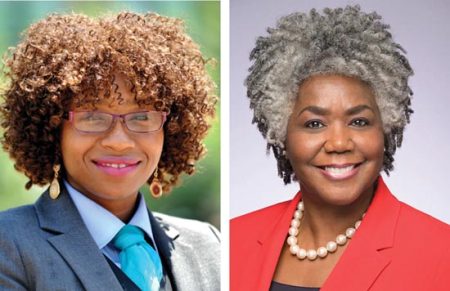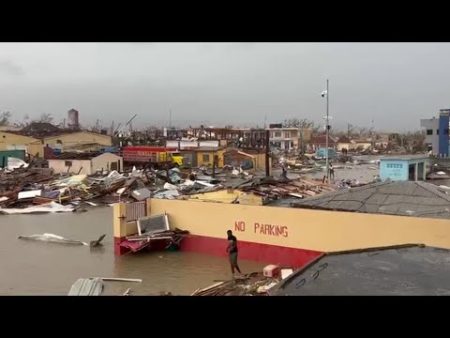A Nation in Crisis

by Johnnie Grant –
The growing national wave of shooting deaths of black men has put our nation on high alert.
As cities erupt in protest after decades of violence at the hands of police, calls for nonviolence can be deafening. “No more violence!” people chant at these rallies—and they’re right; but some feel the message is being directed at the wrong people.
With the exception of the Dallas sniper who killed five police officers on July 7, the violence is aimed primarily at African Americans—not coming from them.
Statistics Tell a Grim Story
Race remains the most volatile flash point in many police shootings. Black men make up only 6% of the U.S. population, but have accounted for 29% of the unarmed men shot to death by police this year. For all of 2015, the total killed by police was 1,146—almost one hundred U.S. residents per month, more than three every day across America, according to The Counted, a project by the British-based newspaper The Guardian.
Already in 2016 an American police officer has shot and killed a civilian nearly six hundred times (585 at press time). Of those 585 killed by police in 2016, 145 were African Americans: 138 shot dead, and 7 killed by other means. That’s this year.

Local Communities Also Affected
Locally, the family of Jai “Jerry” Williams still agonize over his recent death, and questioned whether the police use of lethal force was even necessary. Williams was shot and killed Saturday, July 2, by Asheville Police Sgt. Tyler Radford following a three-mile police pursuit from Pisgah View Apartments to Deaverview Apartments.
Authorities said Williams was armed with an AR-15 and posed a threat to officers. However, witnesses to the shooting say Williams never pointed a gun at the officers, while others dispute that William even had a weapon at all. Genya Williams, Jai’s older brother, does not trust the police investigation, and said, “I want the police to tell the truth.”
 Najiyyah Avery, mother of Jai “Jerry” Williams, shared her memories with The Urban News. “Little Jerry,” she said, using her pet name for her son, “was my creative child, an avid reader, and a player of sports. He was the writer of nine children books, with one book published (Xlibris) titled The Bug & Animal Book. I plan to have all his books edited and published.”
Najiyyah Avery, mother of Jai “Jerry” Williams, shared her memories with The Urban News. “Little Jerry,” she said, using her pet name for her son, “was my creative child, an avid reader, and a player of sports. He was the writer of nine children books, with one book published (Xlibris) titled The Bug & Animal Book. I plan to have all his books edited and published.”
Jerry was also a star football player with Waccamaw Park Youth Football Association in College Park, Georgia. As Najiyyah tells it, “The coaches would always tell Jerry’s teammates to get the ball to Jerry. When Jerry jumped to catch a pass from mid-air, he would take off down the field in pursuit of the touchdown—and he made many touchdowns,” she mused. “But, the most important aspect of Jerry’s personality was that he rallied and supported his team mates much like he supported his family, loved-ones, and friends—he was a team player.”
Tapping Local Resources
Recently, Asheville’s Citizens/Police Advisory Committee met with members of the Asheville Housing Authority’s Resident Council who said their children did not feel safe around police officers. “We are scared of the police probably more than we are scared of the people in our community,” said Sir Charles Gardner, president of the Residents Council of Pisgah View Apartments. “What do you do when you feel you can’t call the police for help?” he said.
Weapons of Less Destruction
Lately there has been a renewed, and increasingly contentious, debate in congress about gun control. Semi-automatic guns were banned for 10 years between 1994 and 2004; obstreperous members of Congress, many funded by the National Rifle Association, have refused to renew the ban, or any other gun control measure, ever since.
Such weapons—those with high-capacity magazines that shoot without pause between rounds—are designed for mass destruction of life, and have been the weapon of choice for the mass shootings in Colorado (Columbine and Aurora), Newtown, Connecticut (Sandy Hook Elementary School), Orlando, Florida (Pulse nightclub), Fort Hood, Texas (2009 and 2014), and elsewhere.
A determined shooter would likely find a weapon other than specifically banned ones; a determined manufacturer will make minor modifications to evade the law, as was done under the 1994 bill. Making such weapons harder to find, more difficult to buy, or limiting the ammunition available for them, would be one step towards rational control.
On another front, video technology has recently proven to be very valuable as a way to dramatically reduce police misconduct and alter how Americans perceive officers’ use of deadly force. Having a video recording can make it much easier to differentiate between a shooting that is clearly justified and one that is not, and what needs to be studied, interpreted, and analyzed in depth.
North Carolina’s legislature passed, and Governor Pat McCrory signed, a new law that severely limits access to video-cam recordings. The law specifically deems police video-recordings from dashcams and body-worn cameras “not public records.” [see “Blue Wall of Silence Law,” page 7]. While there are means for a citizen or attorney to view such recordings, the public and the media will be more dependent than ever on witness-provided videos—such as those made in the Minnesota and Louisiana police shootings this summer—for a record of such incidents.
When to Call the Police for Help…
Criminal justice professor and former Baltimore police officer Peter Moskos said many people think police officers play a role in community affairs. Moskos says, “The idea that cops are always at your beck and call is the basis of the 911 system—and it doesn’t work. When you call the police, you have to remember that what cops do is arrest people. If you don’t want to be arrested, you probably shouldn’t call the police.”
Also See: A Nation in Crisis Photo Gallery








